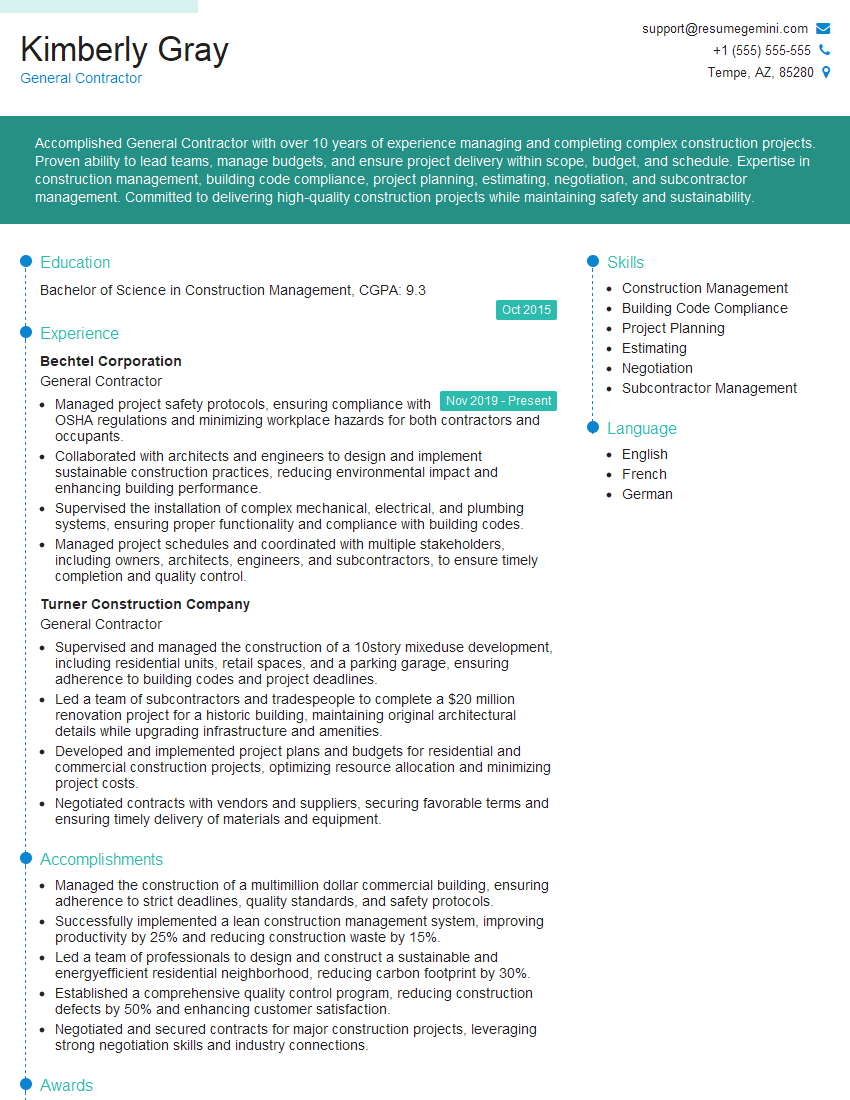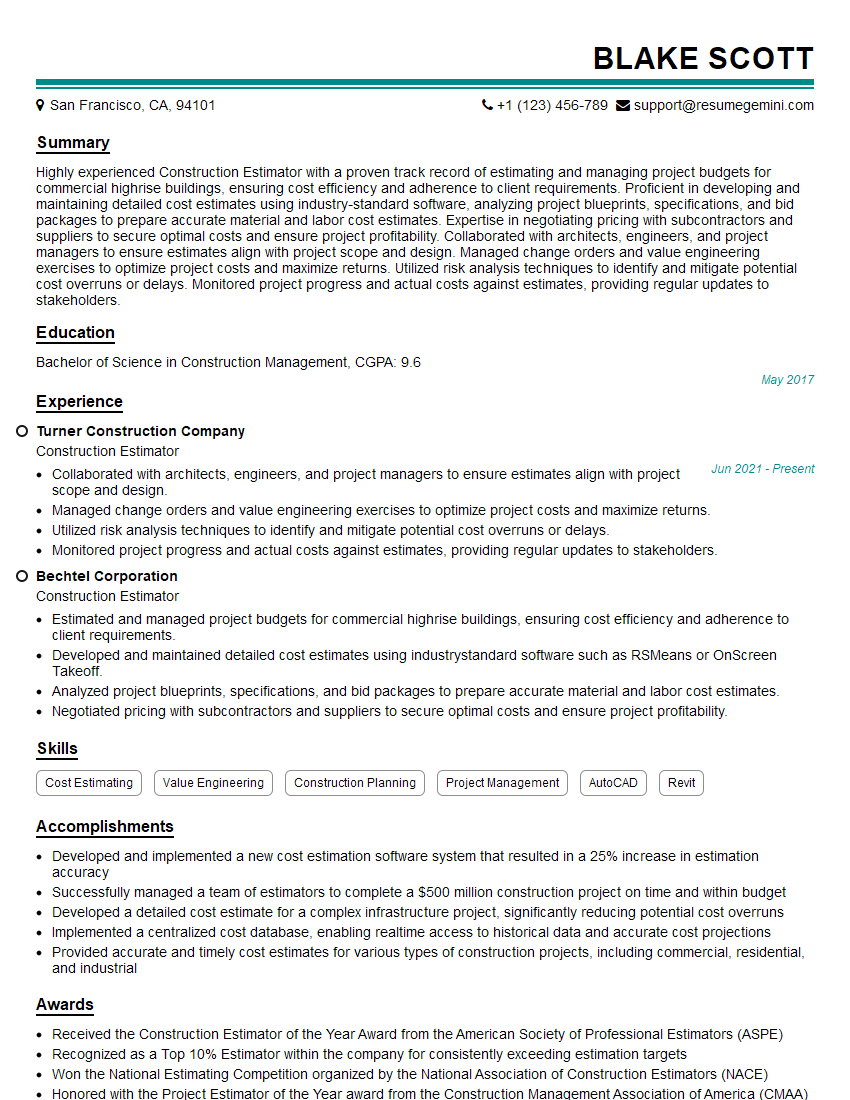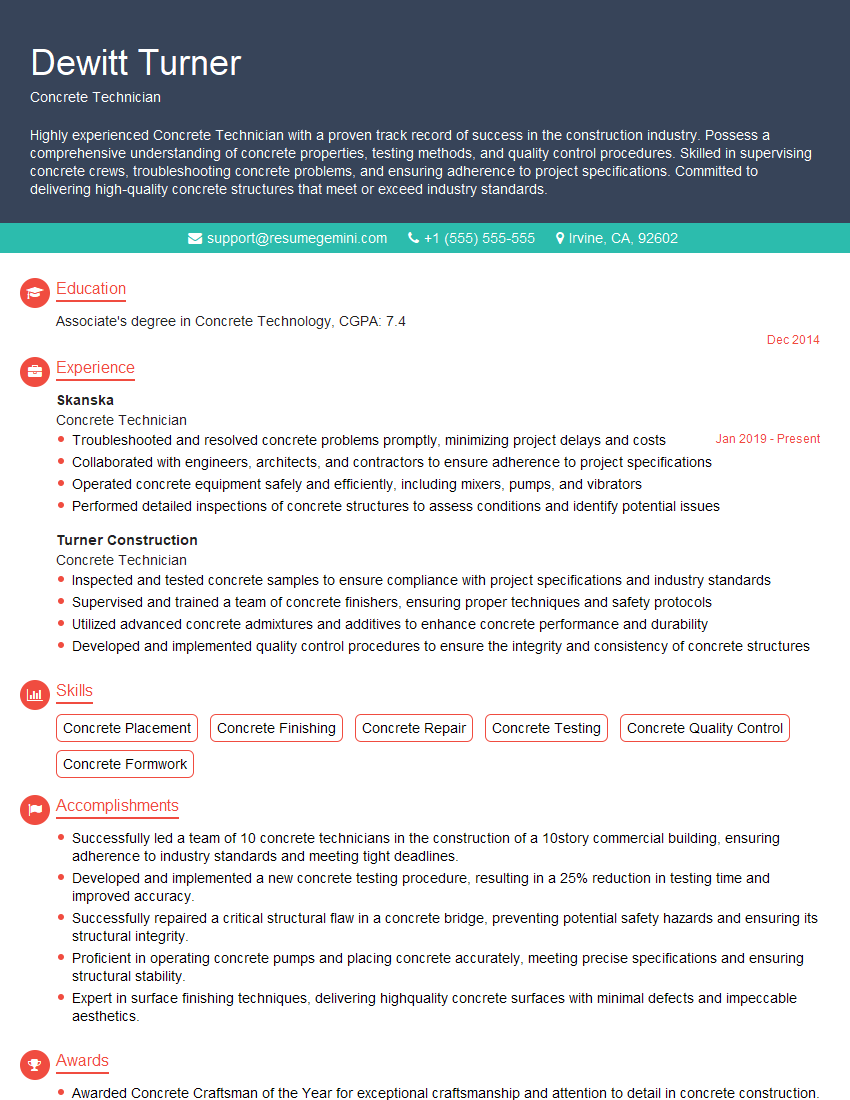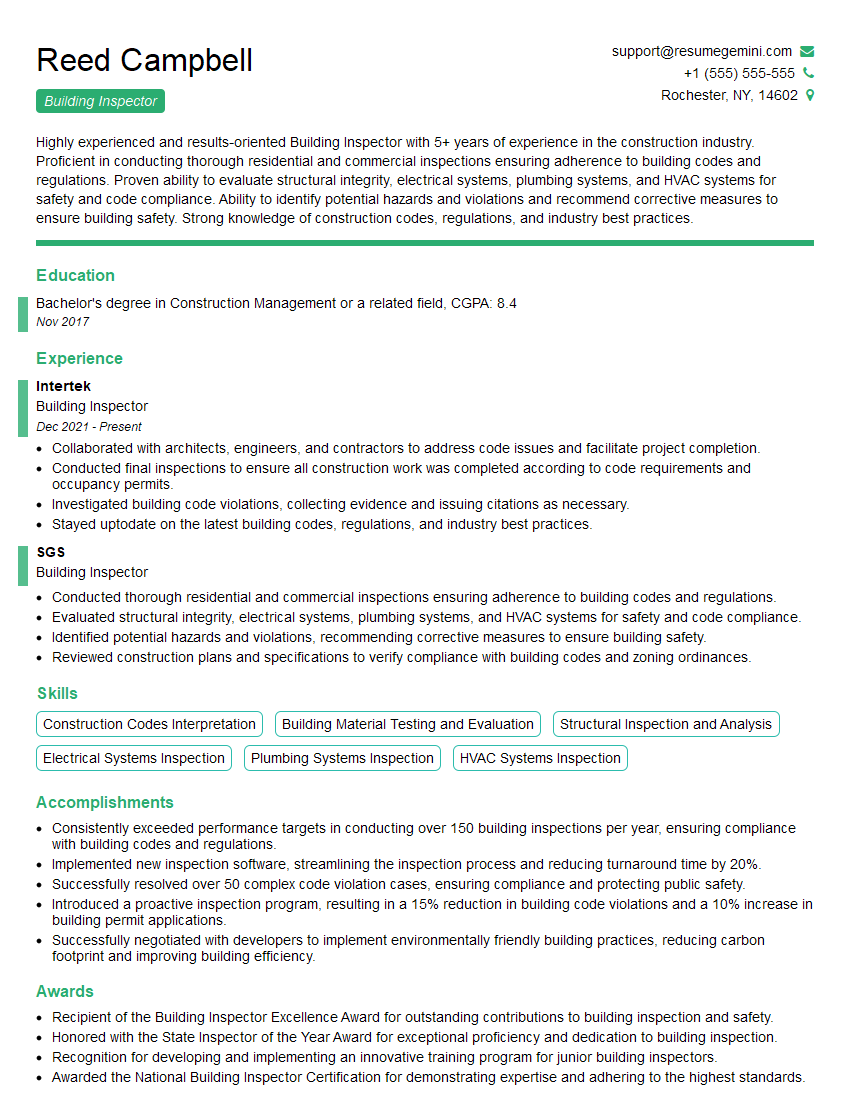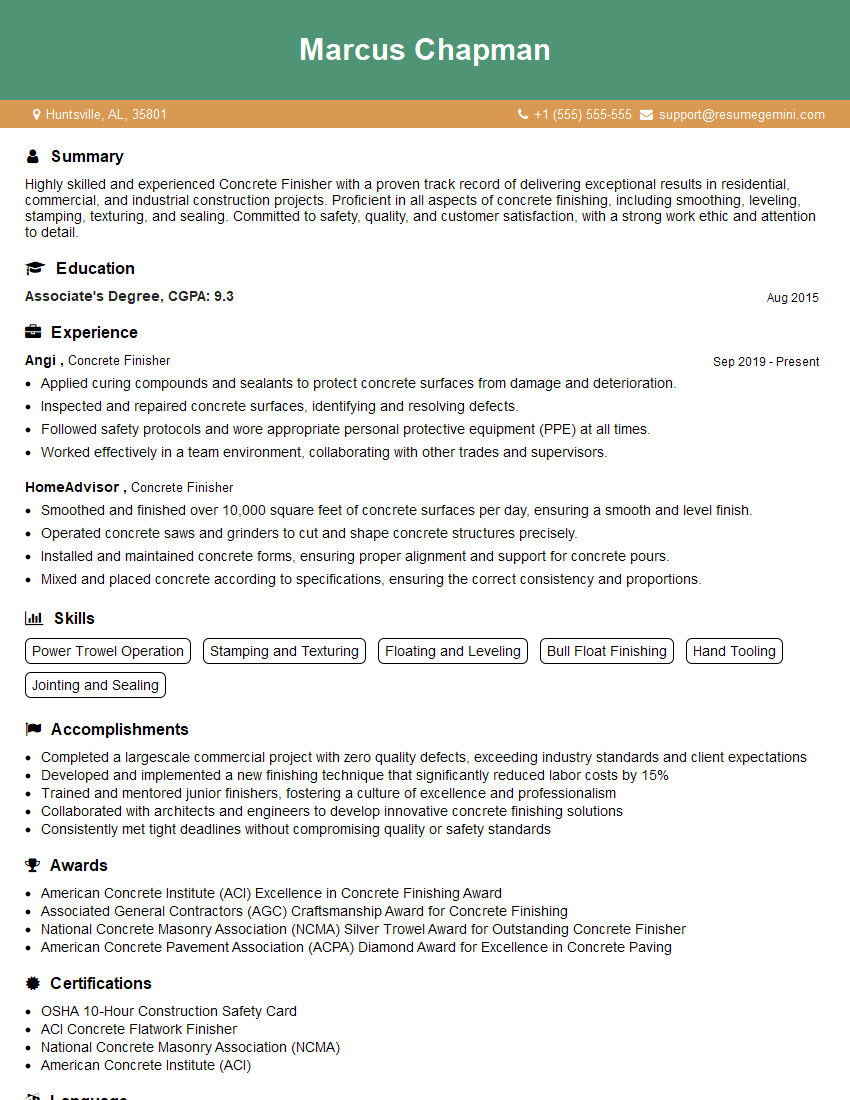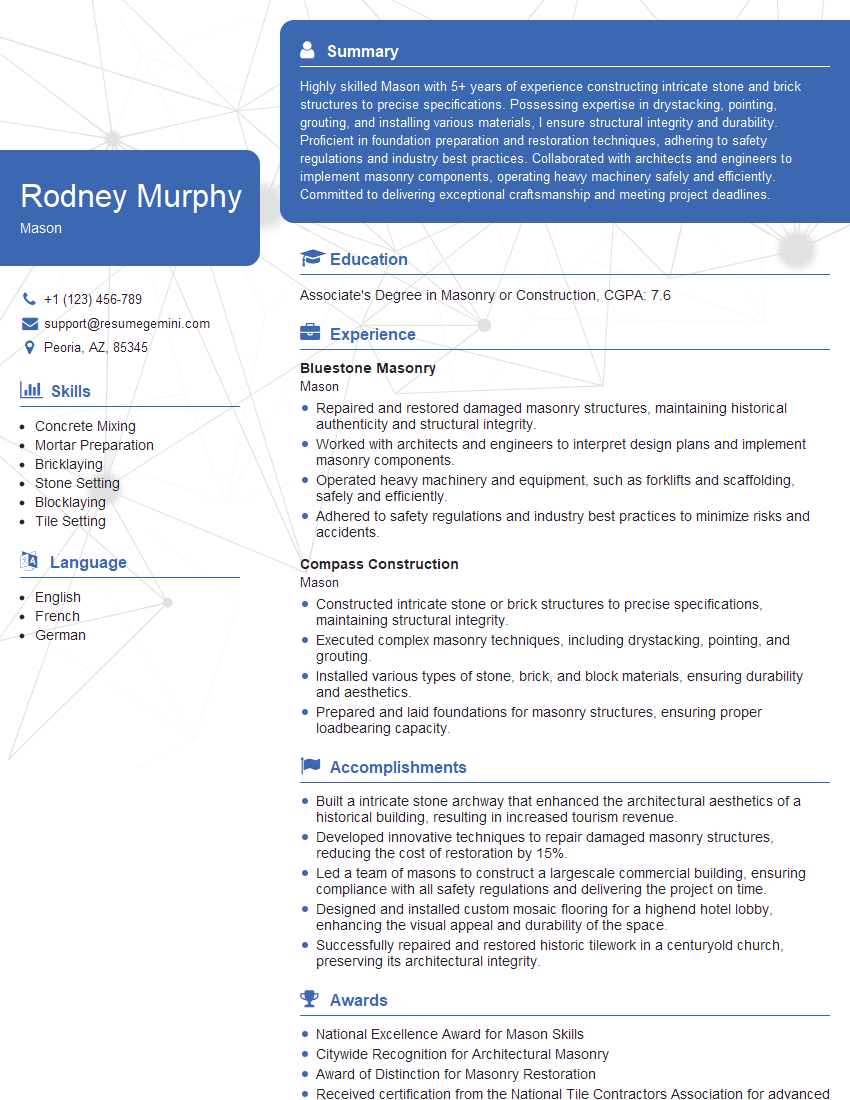Preparation is the key to success in any interview. In this post, we’ll explore crucial Concrete Construction Practices interview questions and equip you with strategies to craft impactful answers. Whether you’re a beginner or a pro, these tips will elevate your preparation.
Questions Asked in Concrete Construction Practices Interview
Q 1. Describe your experience with different concrete mixes and their applications.
My experience encompasses a wide range of concrete mixes, each tailored to specific project needs. Understanding the mix design is crucial; it dictates the concrete’s final properties like strength, workability, and durability. For instance, a high-strength mix (e.g., 5000 psi) is essential for high-rise buildings or bridge supports, requiring a higher cement-to-aggregate ratio. Conversely, a lower-strength mix (e.g., 3000 psi) might suffice for pavements or less demanding applications. I’ve worked with mixes incorporating various admixtures like air-entraining agents (improving freeze-thaw resistance), water reducers (enhancing workability), and accelerators (shortening setting time). For example, on a recent project involving a large retaining wall, we used a mix with a high-range water reducer to ensure proper placement in confined spaces and avoid segregation. Another project involved a specialized mix incorporating fibers for improved crack control in a heavily trafficked industrial floor.
- High-Strength Concrete: Used in structures requiring exceptional load-bearing capacity.
- Normal-Strength Concrete: Suitable for common applications like foundations and slabs.
- Lightweight Concrete: Incorporates lightweight aggregates, reducing the overall weight of the structure.
- High-Performance Concrete: Engineered mixes optimized for specific properties like high strength, durability, or rapid setting.
Q 2. Explain the process of curing concrete and its importance.
Curing is the process of maintaining adequate moisture and temperature in freshly placed concrete to allow for proper hydration of the cement. This crucial step significantly impacts the concrete’s long-term strength, durability, and resistance to cracking. Think of it like nurturing a seed – you need the right conditions for it to grow into a strong plant. Insufficient curing leads to weaker, more brittle concrete prone to early deterioration. Methods include water curing (ponding, spraying, or covering with wet burlap), membrane curing (using plastic sheets), and steam curing (for faster strength gain in precast elements). On a recent project, we employed a combination of ponding and membrane curing for a large slab-on-grade, ensuring even moisture retention throughout the curing period. The duration of curing depends on factors like temperature, humidity, and mix design; generally, it should continue for at least 7 days, but extending it is often beneficial.
Importance:
- Strength Development: Proper hydration is essential for achieving the design strength.
- Durability: Prevents premature cracking and deterioration from environmental factors.
- Reduced Shrinkage: Minimizes internal stresses caused by moisture loss.
Q 3. What are the common causes of concrete cracking and how can they be prevented?
Concrete cracking is a common problem stemming from various factors. Understanding these causes is key to prevention. Plastic shrinkage cracking occurs during the early stages when surface water evaporates too quickly. Drying shrinkage happens as the concrete cures and loses moisture. Thermal cracking results from temperature changes during curing. Reinforcement issues like inadequate spacing or corrosion can also induce cracks. Poor workmanship, such as insufficient consolidation or improper formwork, also plays a significant role. For example, a lack of expansion joints in a long concrete slab can result in extensive cracking due to thermal expansion and contraction.
Prevention Strategies:
- Proper Mix Design: Using the right mix proportions and admixtures.
- Effective Curing: Preventing rapid moisture loss.
- Adequate Reinforcement: Using the right amount and type of reinforcement.
- Control of Temperature Variations: Providing shade during hot weather and insulation during cold weather.
- Use of Expansion Joints: Allowing for thermal movement.
- Careful Placement and Consolidation: Avoiding segregation and ensuring proper compaction.
Q 4. How do you ensure the proper consolidation of concrete during placement?
Proper consolidation of concrete is vital to eliminate air pockets and ensure a dense, homogenous mix. Insufficient consolidation leads to weakness and porosity, compromising the structure’s strength and durability. Methods include vibration (using internal or external vibrators), rodding (for smaller pours), and hand tamping (rarely used in larger projects). The choice depends on the project scale, concrete mix consistency, and formwork constraints. I use vibration extensively; internal vibrators are best for deeper pours and confined spaces, while external vibrators are suitable for surface consolidation. The key is to vibrate until the concrete is free of air bubbles and has a smooth, creamy surface. Over-vibration, however, can lead to segregation, separating cement from aggregates, so it’s a delicate balance. I always monitor the vibration time and observe the concrete’s consistency. Visual inspection remains crucial alongside experience; I’ve learned to recognize subtle cues indicating proper consolidation.
Q 5. What are the different types of formwork systems and their suitability for various projects?
Formwork is the temporary structure supporting fresh concrete until it gains sufficient strength. Several systems exist, each with its strengths and weaknesses. Traditional timber formwork is versatile and cost-effective for smaller projects, but requires more labor. Steel formwork is reusable, ensuring high accuracy and faster construction, ideal for large-scale projects with repetitive elements. Aluminum formwork offers a balance between cost and durability. Prefabricated formwork systems, including those made of plastic or composite materials, offer increased speed and accuracy, especially for specialized shapes. The choice depends on factors such as project size, complexity, budget, and the desired finish. For instance, on a high-rise building, we’d opt for reusable steel formwork for its speed, precision, and ability to withstand the high pressures involved. A smaller residential foundation could use cost-effective timber formwork.
- Timber Formwork: Cost-effective, versatile, but requires more labor.
- Steel Formwork: Reusable, accurate, durable, suitable for large projects.
- Aluminum Formwork: Lighter than steel, offers a balance between cost and performance.
- Prefabricated Formwork: Highly efficient for repetitive elements and specialized shapes.
Q 6. Explain your experience with concrete finishing techniques, including floating, troweling, and brooming.
Concrete finishing techniques are crucial for achieving the desired surface texture and appearance. Floating uses a long, bull float to level the surface and eliminate irregularities. Troweling follows, using steel trowels to create a smoother, more even finish, ranging from a broom finish to a very smooth, polished surface. Brooming is a technique where the concrete is textured with a stiff broom; creating a skid-resistant surface suitable for sidewalks or patios. The specific techniques and their sequence depend on the intended use of the concrete surface. For example, a parking garage needs a troweled finish with potential hardeners, whilst a sidewalk calls for a broom finish for better traction. My experience involves selecting the right technique depending on the client’s needs and the environment the concrete will be exposed to. I’ve even worked on projects requiring specialized finishing methods like exposed aggregate finishes, which involves partially removing the top layer of concrete to reveal the underlying aggregate. All these techniques require skilled workers and attention to detail; even minor variations in technique can significantly affect the final finish.
Q 7. How do you determine the required concrete slump for a particular application?
Concrete slump is a measure of its consistency or workability. It’s determined using a slump cone test, where a standard cone is filled with fresh concrete, then lifted, and the slump (the difference between the cone’s height and the settled concrete height) is measured in inches. The required slump depends on the project’s specifics; factors include the placement method, formwork complexity, and the desired finish. A low slump is appropriate for structures requiring higher strength and minimal segregation (e.g., walls). A high slump is preferable for easily placed concrete, often for larger slabs or structures with extensive reinforcement, making it flow easily around the steel. However, high slump mixes can be prone to segregation and bleeding. It’s a balance. I’ve often worked alongside structural engineers to determine the appropriate slump based on the structural demands and the placement limitations on site. For example, when working with a very congested reinforcement cage in a column, a lower slump would be chosen to avoid segregation and ensure complete encasement of the steel.
Q 8. What safety precautions do you take when working with concrete?
Safety on a concrete jobsite is paramount. It’s not just about following regulations; it’s about a proactive mindset. We start with comprehensive site safety planning, including fall protection measures (scaffolding, harnesses), ensuring proper signage for hazards like open trenches or freshly poured concrete, and mandatory Personal Protective Equipment (PPE) including safety boots, hard hats, safety glasses, and high-visibility vests.
Specific precautions around concrete involve preventing slips and falls from wet surfaces – we use non-slip mats and ensure adequate lighting. We also address the chemical hazards of concrete, providing proper handling instructions for admixtures and emphasizing thorough hand washing. Respiratory protection is crucial when working with dry cement dust, and we always have emergency eyewash stations readily available.
Finally, a robust safety training program is key. Workers receive regular briefings on updated safety procedures, hazard identification, and emergency response plans. We also conduct regular safety inspections and promptly address any identified risks. Think of it like this: a safe worksite is a productive worksite. Preventing injuries is not just ethically responsible; it’s economically sound.
Q 9. Describe your experience with reading and interpreting concrete plans and specifications.
Reading and interpreting concrete plans and specifications is fundamental to my work. I’m proficient in deciphering structural drawings, including details on reinforcement layouts, formwork design, and concrete placement strategies. I understand the significance of specifications related to concrete mix design, strength requirements (specified in terms of compressive strength at a certain age, like 28 days), and slump requirements (consistency of the concrete).
I’ve worked extensively with documents specifying concrete finishes, like exposed aggregate or stamped concrete. I understand how to identify key information such as concrete cover requirements (the distance between reinforcement and the concrete’s surface), which is crucial for corrosion protection, and the tolerances allowed for dimensions and levels. I am also familiar with various concrete testing methods and their associated reporting standards. For example, I can easily understand specifications that call for cylinder compressive strength testing according to ASTM C39.
My experience includes projects with varying levels of complexity, from simple slabs to intricate structural elements, and I am adept at cross-referencing various sections within the specifications to ensure all aspects are considered and coordinated. For instance, in a recent high-rise building project, I carefully analyzed plans to coordinate concrete pours to avoid conflicts with other trades and to ensure proper curing times.
Q 10. How do you address issues like air entrapment and segregation in concrete?
Air entrapment and segregation are common problems in concrete that can significantly reduce its strength and durability. Air entrapment occurs when air bubbles become incorporated into the concrete mix, weakening the final product. Segregation happens when the components of the concrete mix – the cement, aggregates, and water – separate during handling and placement.
Addressing air entrapment involves using proper mixing techniques and selecting appropriate admixtures, such as air-entraining agents which help to stabilize the air bubbles and improve workability. Proper vibration during placement is also crucial to release trapped air. Think of it like gently shaking a soda bottle to release the carbonation; we do the same with the concrete, but with specialized vibrating equipment.
Segregation is tackled by careful handling of the concrete, including controlled placement methods and minimizing the drop height of the concrete during delivery and placement. Using a concrete pump can help avoid excessive free fall. Maintaining the correct water-cement ratio is also critical, as excessive water increases the likelihood of segregation. Proper consolidation through vibration is just as important here as well.
Regular quality control measures, like monitoring the slump and visual inspection of the placed concrete, are vital in catching and correcting any issues early on.
Q 11. What are the different methods for testing the strength of concrete?
Several methods exist for testing concrete strength, each serving a different purpose. The most common is the compressive strength test, where standardized cylindrical specimens (typically 6 inches in diameter and 12 inches high) are cured under controlled conditions and then tested in a compression machine to determine their strength in pounds per square inch (psi) or megapascals (MPa).
In-situ testing methods, like the rebound hammer test, offer a non-destructive way to estimate concrete strength. This involves hitting the concrete surface with a hammer and measuring the rebound distance. While not as precise as lab testing, it’s useful for quick assessments of existing concrete structures. Another common in-situ test is the coring test, where a cylindrical core sample is drilled from the structure and then tested in compression in a laboratory setting.
Other tests include flexural strength tests (measuring tensile strength) and ultrasonic pulse velocity tests which measure the speed of sound waves traveling through the concrete, providing information about its density and potential internal flaws. The choice of testing method depends on factors such as the project’s requirements, the stage of construction, and the need for destructive or non-destructive evaluations.
Q 12. Explain your experience with concrete repair and restoration techniques.
Concrete repair and restoration demands a keen understanding of the causes of deterioration and selecting appropriate repair methods. I have experience in various techniques, including surface patching, crack repair, and the restoration of deteriorated structural members.
Surface patching involves removing loose or unsound concrete and filling the voids with a compatible patching material. Crack repair can range from simple sealing with epoxy resins for minor cracks to more extensive methods involving injection of epoxy or polyurethane resins into larger cracks to stabilize them and prevent further propagation. For larger sections of deteriorated concrete, I’m experienced in techniques involving the removal and replacement of damaged sections and the use of high-strength repair mortars or concretes designed to match the existing structure’s properties.
I’ve also undertaken projects involving the application of protective coatings to enhance durability, and I am familiar with advanced techniques like carbon fiber reinforced polymer (CFRP) strengthening, used to increase the load-bearing capacity of damaged structures. A recent project involved the repair of a bridge deck using high-strength concrete overlays and joint sealing to prevent water ingress and further deterioration. This required careful planning and consideration of factors such as traffic management and the curing process to ensure minimal disruption.
Q 13. How do you handle delays or unexpected problems on a concrete construction project?
Delays and unexpected problems are inevitable in construction. My approach involves proactive risk management throughout the project lifecycle. We start by developing a detailed schedule with realistic timelines, incorporating buffer times to account for unforeseen circumstances. We also create a comprehensive risk assessment, identifying potential issues like material delays, weather disruptions, or unforeseen site conditions.
When problems arise, my strategy is to promptly assess the situation, determine the impact on the overall schedule and budget, and develop a solution. This often involves collaboration with the project team, including subcontractors, engineers, and clients. Effective communication is critical, keeping everyone informed of the situation and the steps being taken to mitigate the delay. We utilize tools such as project management software to track progress, identify potential conflicts, and adjust plans as needed.
For instance, during a recent project, unexpected rock encountered during excavation caused a significant delay. We immediately convened a meeting with the engineers and subcontractors, assessed the extra cost and time, revised the schedule and secured necessary approvals, and adapted our approach to safely remove the rock. Transparency and collaboration minimized the overall impact on the project.
Q 14. What is your experience with different types of concrete admixtures and their functions?
Concrete admixtures are chemical additives that modify the properties of concrete. My experience includes working with a variety of admixtures, each serving a specific purpose.
- Water reducers: These reduce the amount of water needed for a given slump, increasing strength and durability. They’re like adding a lubricant to the mix, making it easier to pour and place.
- Superplasticizers: These are high-range water reducers that significantly increase workability without affecting the water-cement ratio, allowing for the production of high-strength, high-performance concrete.
- Air-entraining admixtures: As mentioned earlier, these help to incorporate air bubbles into the mix, enhancing its freeze-thaw resistance and reducing permeability.
- Accelerators: These speed up the setting and hardening process, allowing for faster construction schedules in favorable weather conditions.
- Retarders: These slow down the setting time, providing extra time to work with the concrete, especially beneficial in hot weather.
- Corrosion inhibitors: These help protect reinforcement steel from corrosion.
Selecting the right admixture requires a thorough understanding of the project’s specific needs and environmental conditions. For example, using a retarder is crucial in hot weather to prevent premature setting, while an accelerator might be beneficial in cold weather to speed up the curing process.
Q 15. Describe your knowledge of different types of concrete structures (e.g., slabs, beams, columns).
Concrete structures are the backbone of many buildings and infrastructure projects. My experience encompasses a wide range of these structures, including slabs, beams, and columns, each with unique design and construction considerations.
- Slabs: These are horizontal structural elements, typically used for floors and pavements. They can range from simple, unreinforced slabs in low-traffic areas to heavily reinforced slabs supporting significant loads, like those in multi-story buildings. I’ve worked on both, understanding the need for proper reinforcement placement and concrete mix design for varying loads and spans.
- Beams: These are horizontal structural members that transfer loads from slabs or walls to columns or supports. Their design depends on the load they carry, span, and support conditions. I’m familiar with various beam types, including simply supported, cantilever, and continuous beams, and have experience with the intricate process of formwork construction and reinforcement detailing to ensure structural integrity.
- Columns: These are vertical structural members that transfer loads from beams and slabs to the foundation. They’re crucial for stability and can be designed as tied columns, braced columns or even composite columns incorporating steel. I’ve been involved in projects involving both reinforced concrete columns and high-strength concrete columns, understanding the significance of proper curing and protection during construction.
Understanding the interplay between these elements and the overall structural design is key to successful concrete construction. For instance, I once worked on a project where improper detailing of beam-column joints led to cracking. We mitigated this by implementing stringent quality control measures and redesigning the critical joints.
Career Expert Tips:
- Ace those interviews! Prepare effectively by reviewing the Top 50 Most Common Interview Questions on ResumeGemini.
- Navigate your job search with confidence! Explore a wide range of Career Tips on ResumeGemini. Learn about common challenges and recommendations to overcome them.
- Craft the perfect resume! Master the Art of Resume Writing with ResumeGemini’s guide. Showcase your unique qualifications and achievements effectively.
- Don’t miss out on holiday savings! Build your dream resume with ResumeGemini’s ATS optimized templates.
Q 16. Explain the importance of quality control in concrete construction.
Quality control in concrete construction is paramount; it ensures the final structure’s safety, durability, and longevity. Skipping corners can lead to significant issues, from minor cracking to catastrophic failure. My approach to quality control involves several key steps, implemented at each stage of the process:
- Material Selection & Testing: Careful selection of aggregates, cement, and admixtures is crucial. I always insist on thorough testing of materials to ensure they meet the specified requirements and comply with relevant standards. This includes testing for compressive strength, slump, air content, and other vital parameters.
- Mixing & Placement: Proper mixing and placement are critical for achieving the desired concrete properties. I monitor the mixing process to ensure the correct water-cement ratio and the homogeneous mixing of all components. Proper compaction techniques are employed to prevent voids and ensure uniform density.
- Curing & Protection: Curing is essential for the development of concrete strength and durability. I implement appropriate curing methods, such as water curing or membrane curing, to ensure adequate moisture retention during the critical initial period. Protecting the concrete from harsh weather conditions like extreme temperatures and rainfall is also crucial.
- Inspection & Documentation: Regular inspection throughout the entire process helps identify potential issues early. Meticulous documentation of all aspects – material testing results, mixing procedures, placement methods, and curing regimes – is vital for traceability and accountability.
Think of it like baking a cake – if you don’t follow the recipe precisely, the outcome won’t be what you intended. Similarly, deviations from the specified concrete mix design and construction procedures can lead to undesirable results.
Q 17. How do you manage a concrete crew effectively and efficiently?
Managing a concrete crew efficiently requires a blend of leadership, technical expertise, and communication skills. My approach centers around:
- Clear Communication: Daily briefings outlining the day’s tasks, safety procedures, and quality standards are essential. I make sure everyone understands their roles and responsibilities and encourage open communication to address any concerns promptly.
- Safety First: A safe work environment is my top priority. I enforce strict adherence to safety regulations, provide necessary safety equipment, and conduct regular safety training. I believe that a safe crew is a productive crew.
- Organized Workflows: I plan concrete placement meticulously, anticipating potential challenges and allocating resources effectively. This involves coordinating material delivery, formwork erection, reinforcement placement, and concrete pumping seamlessly to minimize downtime and ensure smooth operation.
- Motivation & Teamwork: I foster a team spirit by recognizing good work, providing constructive feedback, and creating an environment of mutual respect and trust. A motivated and collaborative team is more productive and delivers higher-quality results.
On a recent high-rise project, we faced a tight deadline. By implementing efficient workflows and fostering strong teamwork, my crew successfully completed the concrete pour on time and without any quality compromises.
Q 18. What experience do you have with different types of concrete finishing tools?
My experience with concrete finishing tools is extensive, covering a variety of tools for achieving different surface finishes. Here are some examples:
- Bull Floats: Used for initial leveling and smoothing of large concrete surfaces. I’m proficient in using both power bull floats and hand bull floats, adjusting techniques to suit the project’s scale and desired finish.
- Hand Floats: Used for final smoothing and achieving a fine finish on smaller areas or around edges. Different hand floats offer varied degrees of smoothness.
- Trowels: Steel trowels are used to create a smooth, even surface. I can use various trowels to create different finishes, from a smooth, broom-finished surface to a highly polished finish.
- Power Trowels: For very large areas requiring a polished finish, power trowels are extremely effective. I’m adept at operating different power trowels and understanding their limitations to ensure an even and high-quality result.
- Groovers: Used to create control joints to manage shrinkage cracking and enhance the concrete’s durability. The selection of groover type and spacing depends heavily on the overall design.
Choosing the right tool for the job and mastering its use are critical for achieving the desired surface finish and ensuring the concrete’s durability. For example, improper use of a power trowel can lead to surface imperfections or even damage the concrete.
Q 19. Describe your experience with working with different types of aggregates.
My work has involved numerous aggregate types, each with its unique characteristics impacting the concrete’s final properties. I understand that the choice of aggregate significantly influences the cost, durability, and workability of the concrete.
- Crushed Stone: Commonly used for its strength and durability. Different stone types, like limestone or granite, offer varying strengths and aesthetics. I’ve worked with projects using both, tailoring the mix design to maximize the stone’s benefits.
- Gravel: A readily available aggregate, often used for less demanding applications. The size and shape of gravel significantly influence the concrete’s workability. I’ve learned to adjust the mix based on the gravel’s characteristics to achieve the desired consistency.
- Recycled Aggregates: Environmentally friendly alternatives, these aggregates can be derived from various sources, such as crushed concrete or recycled glass. Their use requires careful consideration of their properties and potential impact on the concrete’s performance. I’ve worked with several projects incorporating recycled aggregates, emphasizing thorough testing to ensure they meet the specifications.
For a recent project involving a sustainable building, we incorporated recycled aggregates. We conducted thorough testing to ensure they met the strength and durability requirements while promoting environmentally conscious construction. The project was a success, demonstrating the viability of using sustainable materials without compromising quality.
Q 20. Explain your knowledge of concrete durability and its factors.
Concrete durability is crucial; it determines the structure’s lifespan and ability to withstand environmental stresses. Many factors influence it:
- Concrete Mix Design: The water-cement ratio is paramount. A lower water-cement ratio leads to higher strength and durability. The type and quality of cement and aggregates also significantly influence durability.
- Curing: Proper curing is essential for strength development and prevents early-age cracking. I always ensure adequate moisture retention during the critical curing period to prevent premature drying shrinkage.
- Exposure Conditions: Environmental factors like freeze-thaw cycles, de-icing salts, and aggressive chemicals significantly affect concrete’s durability. I select concrete mixes and protection strategies (e.g., coatings) tailored to the specific exposure conditions of each project.
- Construction Practices: Proper compaction, finishing, and jointing practices prevent defects that can compromise durability. For example, improper compaction can lead to increased porosity, making the concrete more susceptible to damage. I prioritize stringent quality control measures at every stage of construction.
I once encountered a situation where a concrete structure showed significant deterioration due to exposure to de-icing salts. We addressed this by applying a specialized protective coating to improve the concrete’s resistance to these chemicals. This highlights the importance of considering environmental factors and selecting appropriate materials and protective measures.
Q 21. How do you manage concrete placement in challenging weather conditions?
Concrete placement in challenging weather conditions requires careful planning and adaptation of techniques. My strategies include:
- Extreme Heat: Increased evaporation in hot weather weakens the concrete. We use techniques such as windbreaks, shading, and frequent curing to maintain moisture and reduce evaporation. Cold-added water may also be necessary to control the concrete temperature.
- Extreme Cold: Freezing temperatures can damage the concrete before it sets. We use insulated forms, heated aggregates, and possibly anti-freeze admixtures to prevent freezing during placement and curing. I also monitor the concrete temperature carefully using thermometers.
- Rain: Rain can wash away cement and weaken the concrete. We often use protective covers, tarps, or other measures to shield the concrete from rain during placement and the initial curing period.
- Wind: High winds can hinder concrete pumping and placement. We adapt the pumping strategy to account for wind conditions and take precautions to prevent wind from negatively impacting freshly placed concrete.
During a winter project, we encountered freezing temperatures. We used heated aggregates and insulated forms, enabling us to successfully place and cure the concrete while maintaining structural integrity. This underscores the need for flexible and adaptive strategies based on the prevalent weather conditions.
Q 22. What is your experience with using concrete placing equipment (e.g., pumps, conveyors)?
My experience with concrete placing equipment is extensive, encompassing various types of pumps and conveyors. I’m proficient with boom pumps, truck-mounted pumps, and line pumps, understanding their operational limitations and optimal applications. For instance, on a recent high-rise project, we utilized a boom pump to reach challenging heights and placements, ensuring efficient concrete delivery to the upper floors. In another project, involving a large-scale foundation, we employed a conveyor system to manage the continuous flow of concrete efficiently and minimise disruption.
My expertise extends beyond mere operation; I understand the importance of pump maintenance and preventative measures to avoid downtime. I’m familiar with troubleshooting common issues and ensuring the equipment is properly set up for different concrete mixes and placement requirements. I also have experience with selecting the appropriate equipment based on factors like project size, accessibility, and the concrete’s slump.
Q 23. How do you ensure the proper placement and compaction of concrete?
Ensuring proper placement and compaction is critical for achieving durable and high-quality concrete structures. It’s a multi-step process starting with the initial placement, followed by consolidation, and finishing. Proper placement involves distributing the concrete evenly to prevent segregation (separation of aggregates and cement paste) and ensure complete filling of the formwork. This often involves using techniques such as the use of vibrating equipment and controlled pouring.
Compaction, or consolidation, removes trapped air and excess water, increasing the concrete’s strength and durability. We achieve this through vibration—using internal or external vibrators—ensuring the concrete flows smoothly into the formwork, eliminating voids and achieving proper density. The frequency and duration of vibration are crucial and depend on factors such as concrete consistency, type of vibrator, and formwork design.
For example, on a recent bridge project, meticulous placement and compaction were vital. We used a combination of internal and external vibrators, carefully monitoring the consolidation process to avoid over-vibration and potential damage to the reinforcement.
Q 24. Describe your experience with different concrete surface treatments.
My experience with concrete surface treatments is diverse, ranging from simple finishing techniques to specialized coatings. I’m familiar with various methods, including brooming, floating, troweling, and power floating, each achieving different surface textures and finishes. For example, brooming creates a textured surface, ideal for preventing slipping, while power floating provides a smooth, polished finish.
Beyond basic finishing, I have experience with applying a variety of surface treatments including sealers, stains, and coatings designed to enhance durability, aesthetics, and resistance to wear, chemicals, or freeze-thaw cycles. Specific choices depend heavily on the intended use of the concrete and environmental factors. For instance, a decorative concrete patio might require a stain and sealer, while an industrial floor might need a protective epoxy coating. Selecting the appropriate treatment requires understanding the long-term performance requirements of the structure.
Q 25. How do you handle disputes or conflicts on a concrete construction project?
Handling disputes on a concrete construction project requires a proactive and collaborative approach. My strategy focuses on open communication and clear documentation. From the outset, I ensure that all parties involved have a clear understanding of the project scope, specifications, and timelines. Regular progress meetings, detailed reports, and thorough documentation of decisions and changes prevent misunderstandings.
When disagreements arise, I facilitate constructive dialogue, encouraging all parties to express their concerns and perspectives. I aim to find mutually agreeable solutions through negotiation and compromise. However, if negotiation fails, I’m prepared to escalate the issue through established channels, such as mediation or arbitration, while adhering to contractual agreements and industry standards.
For example, on a recent project, a dispute arose regarding the interpretation of a specification. By reviewing the contract documents, communicating clearly with all stakeholders and providing evidence-based arguments, I was able to facilitate a resolution that satisfied everyone involved, avoiding costly delays.
Q 26. What are your salary expectations?
My salary expectations are commensurate with my experience and skills, and competitive within the current market rate for a domain expert in concrete construction. I am open to discussing a specific range after learning more about the compensation and benefits package associated with this position.
Q 27. What are your career goals in concrete construction?
My career goals in concrete construction involve continued professional development and advancement within a reputable organization. I aim to enhance my expertise in sustainable concrete practices and innovative construction techniques. Ultimately, I strive to contribute to high-quality, durable, and environmentally responsible projects. My long-term aspirations include taking on leadership roles, mentoring younger professionals, and further contributing to industry best practices.
Q 28. What is your availability to start?
I am available to start immediately. I am flexible and can adjust my start date to accommodate any necessary onboarding processes.
Key Topics to Learn for Concrete Construction Practices Interview
- Mix Design and Properties: Understanding the components of concrete (cement, aggregates, water, admixtures), their influence on workability, strength, and durability. Practical application: Calculating mix proportions based on project requirements and available materials.
- Formwork and Shoring: Design, construction, and safety aspects of formwork systems for various concrete elements (slabs, beams, columns, walls). Practical application: Selecting appropriate formwork types based on project design and budget constraints; understanding shoring requirements for safety and structural integrity.
- Concrete Placement and Finishing: Methods of concrete placement (pumping, placing, vibration), techniques for achieving a smooth and durable surface finish. Practical application: Troubleshooting common placement issues such as segregation and honeycombing; understanding different finishing techniques for various applications (e.g., pavements, walls).
- Curing and Protection: Methods and importance of curing concrete to achieve desired strength and durability. Practical application: Selecting appropriate curing methods based on project conditions and concrete type; understanding the impact of environmental factors on curing.
- Quality Control and Testing: Methods for ensuring concrete meets specified quality standards (slump tests, compressive strength tests). Practical application: Interpreting test results and identifying potential issues; understanding quality control procedures throughout the construction process.
- Reinforcement and Embedments: Understanding the role of reinforcing steel in concrete structures, proper placement techniques, and connection details. Practical application: Reading and interpreting reinforcement drawings; ensuring proper cover and spacing of reinforcement bars.
- Safety Regulations and Practices: Understanding and complying with relevant safety regulations and procedures in concrete construction. Practical application: Identifying and mitigating potential hazards on a concrete construction site; following appropriate safety protocols for equipment operation and material handling.
Next Steps
Mastering Concrete Construction Practices is crucial for career advancement in this dynamic field. A strong understanding of these principles opens doors to higher-level positions and greater earning potential. To maximize your job prospects, create an ATS-friendly resume that highlights your skills and experience effectively. ResumeGemini is a trusted resource to help you build a professional and impactful resume. We provide examples of resumes tailored to Concrete Construction Practices to help you showcase your qualifications.
Explore more articles
Users Rating of Our Blogs
Share Your Experience
We value your feedback! Please rate our content and share your thoughts (optional).
What Readers Say About Our Blog
This was kind of a unique content I found around the specialized skills. Very helpful questions and good detailed answers.
Very Helpful blog, thank you Interviewgemini team.


